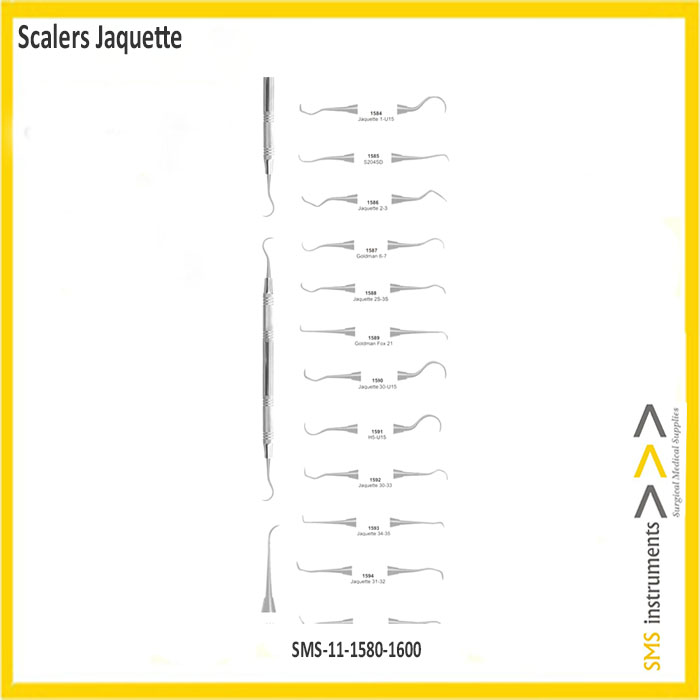Description
Scalers
Size:
1580 – 33-U15, 1581 – S204, 1582 – Jack-Nebraska, 1583 – S204S, 1584 – 1-U15, 1585 -S204SD, 1586 – 2-3, 1587 – 6-7, 1588 – 2S-3S, 1589 – 21, 1590 – 30-U15, 1591 – H5-U15, 1592 – 30-33, 1593 – 34-35, 1594 – 31-32, 1595 – Thompson Jr, 1596 – 33-H5, 1597 – UT107-108, 1598 – U 6-7, 1599 – UP128, 1600 – 128L
Dental Instruments
204S
SMS 204S Scaler is a double-ended dental instrument primarily used for removal of hardened plaque or tartar. The grooved, octagonal handle offers an improved grip.
204SD
SMS # 204SD Scaler is a double-ended dental instrument primarily used for removing tartar. It features longer shanks allowing the user access to distal areas.
Jacquette Scaler 34 – 35
SMS Jacquette scaler is also know as a sickle scaler. It is a periodontal instrument used to remove plaque, endotoxins and calulus from teeth. They come in curved or straight blade ends. Jacquettes are available in several tip configurations, also double or single end; and round printed textured.
Thompson Jr.
SMS Scalers are used for the removal of supragingival calculus and deposits.
UT 107-108
SMS Dental Hand Instruments hold a sharp edge longer and resist breakage and corrosion due to their M.G Stainless Steel construction.
Jaquette 2-3, 2S-3S, 30-33, 31-32, 5H-33,
SMS Jacquette scaler is also know as a sickle scaler. It is a periodontal instrument used to remove plaque, endotoxins and calulus from teeth. They come in curved or straight blade ends. Jacquettes are available in several tip configurations, also double or single end; and textured or octagonal handle.
U15-30
SMS Double-Ended Scaler U15/30 Scaler is a dental instrument that can be used the front teeth for removal of supragingival calculus. This product features a octagonal handle approximately 6.5 mm in diameter.
| Surname | Scalers |
| Tip Configuration | Pointed |
| Size / Model / Figure | No.204, 204S, 204SD, 6-7, FOX 21, U15-H5, 34-35, UT107-108, UP128, U15-1, 2-3, 2S-3S, U15-30, 30-33, 31-32, H5-33, U6-7, 128L |
| Curvature | Angled |
| Handle | Round Printed Textured Double Ended |
| Handle Options | Available | Can Customize |
| Finishing | Mirror Polish Finishing / Matt |
| Instrument Type | Scaler Hand Instruments |
| Material | Stainless Steel |
| Disposable or Reusable | Reusable |
| Rusting Prevention | Passivation Processed |
| Cleaning | Ultrasonic Cleaned |
| Sterile or Non-Sterile | Non-Sterile |
| Latex or Latex-Free | Latex-Free |
| Test Performed | Boil, Shape & Performance Test |
| Grade | Premium OR-Grade |
| Packing | Individually Packed in SMS Brand printed Poly-sleeve |
Scaler | Hand Instruments
Scaler is a dental instrument for removal of plaque, bacterial endotoxins, and calculus from teeth.
Scaling is a means of removing plaque and calculus and smoothing irregular surfaces of the root surface. High quality hand instruments enable hygienists to perform scaling efficiently and effectively, helping to ensure better patient care.
Hand instruments should be used to remove large, bulky supragingival deposits before going on to powered scalers.
Each hand instrument has a handle, a shank and a working tip. The handle is available in different shapes and styles to reduce repetitive strain and hand fatigue, as well as allowing better tactile sensation. E.g; round, hollow handles are recommended because they are lighter in weight, which increases tactile sense, and minimizes hand fatigue whilst a handle with a larger diameter is more ergonomically comfortable. Textured handles (vs smooth handles) are easier to hold and maintain a grip, allowing the operator to maintain better control.
The part of the instrument that extends from the working end to the handle is called the functional shank. Functional shanks may be angled, curved or straight. The variations in length, flexibility and curvature available allow access to different teeth, and different aspects of these teeth, in human dentistry.
The working end refers to the part of the instrument that is used to carry out its function. Working ends can be made of stainless steel or of carbide steel. The working end of a sharpened instrument is called the blade. Carbide blades may hold their cutting edge longer but tend to corrode easily if not cared for properly.
Hand scalers have a sharp cutting edge ending with a pointed tip whilst hand curettes end with a rounded toe to avoid trauma to the tissue when used subgingivally. If a scaler is used subgingivally, the pointed tip will lacerate the gingival margin.
Scalers should be used by gently pulling away from the gingival margin towards the tip of the crown.









